Council Tax reduction in Scotland: 2018-2019
Council Tax reduction (CTR) awarded by age, household structure, income sources and employment status, the deprivation index, and Council Tax band in the financial year from April 2018 till March 2019.
This document is part of a collection
2. Number of CTR recipients
CTR data is reported quarterly and this section updates previous publications. The number of recipients for each local authority in January, February and March 2019 is shown in Table 2. The total number of recipients in Scotland increased from 475,470 in January 2019 to 477,800 recipients in March 2019. This is in line with previous seasonal trends. Details of recipients and income forgone since the inception of CTR are available in the Caseload and Income Forgone tables published at the same time.
Table 2: CTR Recipients by Local Authority, January to March 2019 1, 2
| Jan-19 | Feb-19 | Mar-19 | |
|---|---|---|---|
| Scotland | 475,470 | 477,110 | 477,800 |
| Aberdeen City | 13,790 | 13,820 | 13,810 |
| Aberdeenshire | 11,550 | 11,680 | 11,790 |
| Angus | 8,610 | 8,680 | 8,660 |
| Argyll and Bute | 6,690 | 6,780 | 6,820 |
| City of Edinburgh | 33,090 | 33,510 | 33,460 |
| Clackmannanshire | 5,040 | 5,100 | 5,140 |
| Dumfries and Galloway | 13,170 | 13,210 | 13,250 |
| Dundee City | 17,550 | 17,610 | 17,730 |
| East Ayrshire | 13,130 | 13,150 | 13,210 |
| East Dunbartonshire | 5,410 | 5,470 | 5,480 |
| East Lothian | 6,870 | 6,850 | 6,870 |
| East Renfrewshire | 4,340 | 4,350 | 4,350 |
| Falkirk | 12,880 | 12,900 | 12,860 |
| Fife | 31,140 | 31,180 | 31,190 |
| Glasgow City | 88,090 | 88,480 | 88,660 |
| Highland | 16,980 | 17,040 | 17,110 |
| Inverclyde | 9,700 | 9,710 | 9,850 |
| Midlothian | 6,370 | 6,360 | 6,330 |
| Moray | 5,570 | 5,580 | 5,580 |
| Na h-Eileanan Siar | 2,170 | 2,150 | 2,160 |
| North Ayrshire | 16,570 | 16,540 | 16,490 |
| North Lanarkshire | 36,320 | 36,060 | 36,330 |
| Orkney Islands | 1,200 | 1,220 | 1,230 |
| Perth and Kinross | 8,560 | 8,520 | 8,490 |
| Renfrewshire | 18,060 | 18,160 | 18,120 |
| Scottish Borders | 8,370 | 8,590 | 8,450 |
| Shetland Islands | 1,050 | 1,060 | 1,070 |
| South Ayrshire | 10,810 | 10,820 | 10,780 |
| South Lanarkshire | 30,250 | 30,360 | 30,270 |
| Stirling | 5,490 | 5,490 | 5,470 |
| West Dunbartonshire | 11,900 | 11,810 | 11,800 |
| West Lothian | 14,750 | 14,870 | 15,010 |
Notes:
1 Recipients are as at monthly count date. See Methodology Notes, Section 2 for more details. Available at: http://www.gov.scot/Topics/Statistics/Browse/Local-Government-Finance/Methodology/Ctaxreductionmethod
2 Figures are rounded to the nearest 10. Components may not sum to total due to rounding.
In March 2019, the five local authorities with the highest numbers of CTR recipients accounted for almost half (46 per cent) of the total for Scotland. Glasgow City accounted for the highest proportion, with 19 per cent (88,660 recipients) of the total; followed by North Lanarkshire, accounting for 8 per cent (36,330 recipients); City of Edinburgh and Fife, accounting for 7 per cent (33,460 and 31,190 recipients respectively); and South Lanarkshire, accounting for 6 per cent (30,270 recipients).
The three islands authorities had the smallest share of the caseload with only 0.5 per cent in Na h-Eileanan Siar (2,160 recipients), 0.3 per cent in Orkney (1,230 recipients) and 0.2 per cent (1,070 recipients) in Shetland.
Figure 3 shows CTR recipients by local authority for March 2019 in a Pareto Chart. This allows a visual comparison of the number of recipients in each local authority.
Chart 2: Pareto Chart of CTR recipients, March 2019
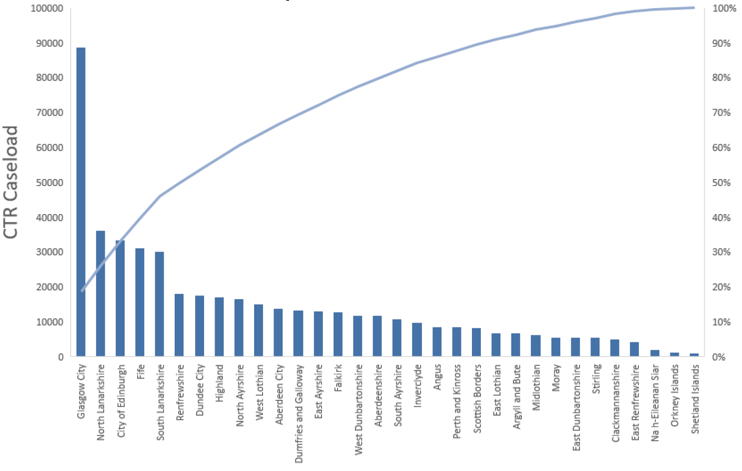
2.1 CTR recipients over time
The number of households receiving CTR in Scotland fell from 552,380 in April 2013 to 477,800 in March 2019, a decrease of under 14 per cent (74,580 recipients). Chart 1 (on page 2 above) shows the downward trend in the number of recipients over this period.
All local authorities in Scotland have seen a decrease in the number of CTR recipients since the scheme was introduced in April 2013. Chart 3 shows the percentage change between April 2013 and March 2019 for all local authorities in Scotland.
Chart 3: Percentage decrease in CTR recipients by local authority, April 2013 to March 2019
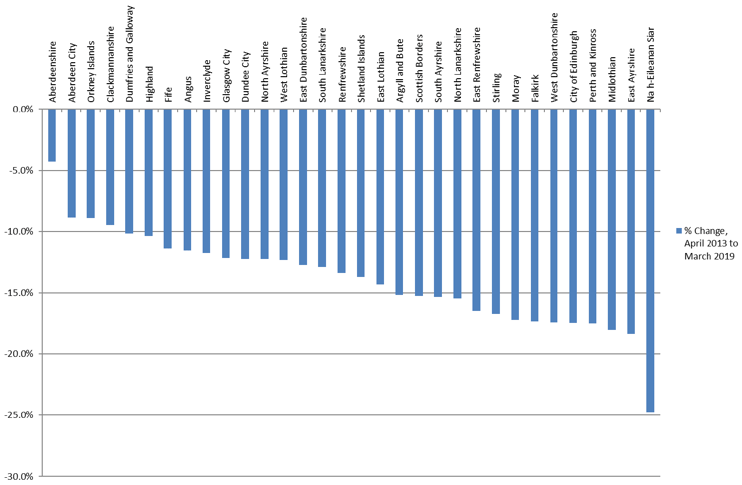
The largest percentage decreases in number of recipients were seen in Na h-Eileanan Siar (24.7 per cent), East Ayrshire (18.4 per cent) and Midlothian (18.0 per cent). Whilst Na h-Eileanan Siar has relatively a large percentage decrease, this represents a relatively small number of recipients. The smallest percentage decreases were seen in Aberdeenshire (4.3 per cent), Aberdeen City (8.8 per cent) and Orkney (8.9 per cent).
The number of recipients for each local authority for each month between April 2018 and March 2019 are provided in the supplementary tables.
2.2 CTR recipients by passported status
In March 2019, passported recipients accounted for 58 per cent of all CTR recipients. This down from 63 per cent in Mach 2018. UC is not passported so, as UC is rolled out - replacing passported benefits, the number of non-passported cases is expected to increase. The most common passporting benefits were income-related Employment and Support Allowance and Pension Credit (Guarantee Credit) which made up just under half of all CTR recipients. The majority of non-passported recipients were not in employment.
Chart 4: CTR recipients by passported status, March 2019
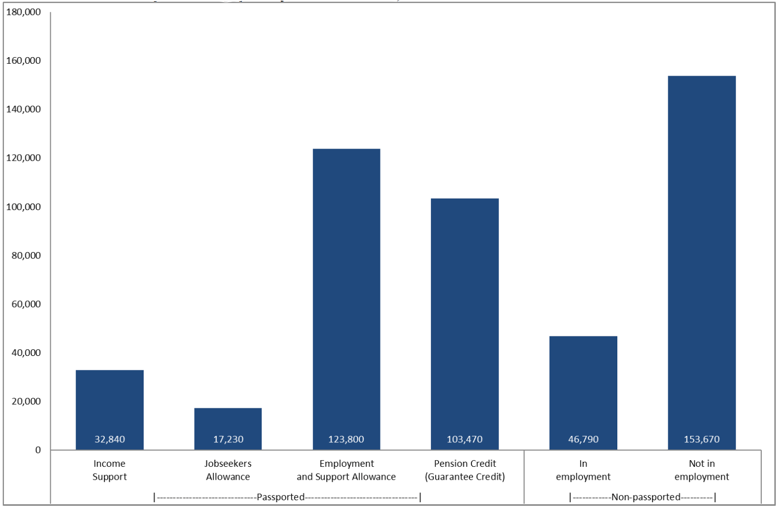
The number of recipients by passported status and local authority in March 2019 is available in the supplementary tables. Some key variations across local authorities are:
Glasgow and Na h-Eileanan Siar had the highest proportion of passported CTR recipients (68 per cent and 67 per cent respectively).
East Lothian has the lowest proportion of passported CTR recipients at 44 per cent. East Lothian was the first local authority in Scotland to have Universal Credit (UC) 'Full Service' rolled out. UC replaces four benefits that currently passport recipients to full CTR (except where non-dependents are present in the household), as well as two tax credits. A similar proportion of 48 per cent applies in both Highland and Inverclyde – also subject to an early roll out of UC.
The number of recipients by passported status from April 2018 to March 2019 is available in the supplementary tables published with this publication. The figures show that the number of passported CTR recipients has decreased whereas the number of non-passported recipients increased. As mentioned in the start of this section of the report, as the roll-out of UC continues, the proportion of CTR cases classed as passported will decrease.
2.3 CTR recipients by age and family type
Chart 5 shows the number of CTR recipients by age group in March 2019. The age group with the highest proportion of CTR recipients was 65 or over, at 37 per cent (175,240 recipients). The age group with the lowest proportion were those under 25 at just over three per cent (16,450 recipients).
Chart 5: CTR recipients by age group, March 2019
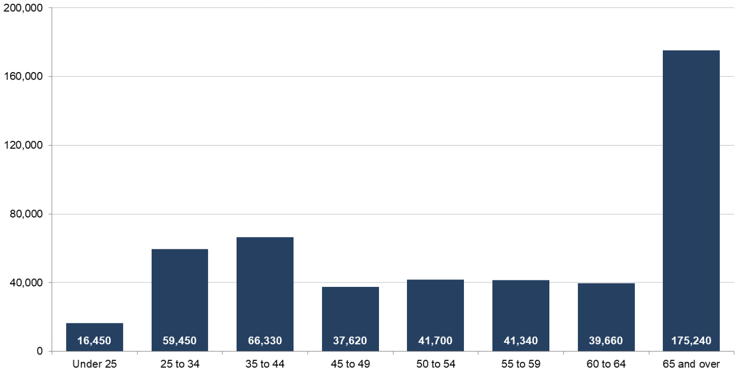
Chart 6 shows the number of CTR recipients by family type in March 2019. The majority of CTR recipients (66 per cent) were single with no child dependent. Lone parents made up 17 per cent, and 17 per cent were couples (with and without children).
Chart 6: CTR recipients by family type, March 2019
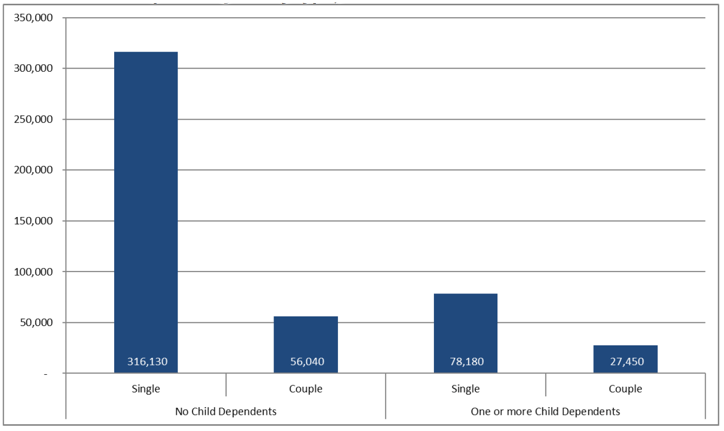
2.4 CTR recipients by deprivation
The Scottish Index of Multiple Deprivation (SIMD) is the Scottish Government's official tool for identifying area of multiple deprivation. It divides Scotland into 6,976 datazones, each containing around 350 households or an average of 760 people. Each datazone has a calculated 'deprivation score' and these scores are then used to rank the datazones. Decile 1 contains the ten per cent most deprived datazones, Decile 2 the next ten per cent most deprived, and so on.
It should be noted that the overall SIMD score is a relative measure and assesses deprivation across seven domains – income, employment, health, education, housing, geographic access to services and crime. The CTR scheme is principally concerned with income and household circumstances as a basis for making awards (see Figure 2 above).
Chart 7 shows the spread of CTR recipients across areas of deprivation using SIMD deciles as described. t can be observed that CTR recipients are heavily concentrated in areas of highest deprivation, with 58 per cent of recipients (275,800) in the lowest three deciles in March 2019. This compares to 50 per cent in March 2017.
Chart 7: CTR recipients by SIMD Decile, March 2019

Note
1 This chart is generated by matching of postcodes to datazones. Some 2,834 postcode records in the CTR Extract for March 2019 cannot be matched with those in the SIMD.
2 Further details on SIMD are available at http://www.gov.scot/Topics/Statistics/SIMD.
2.5 Full and partial CTR
Full CTR refers to recipients whose Council Tax liability is reduced to zero. Partial CTR refers to recipients whose Council Tax liability is reduced, but they are still liable to pay some CT. Further details on these terms and how CTR is calculated are given in Section 1.1.
In March 2019, 57 per cent of CTR recipients (271,670) had been awarded full CTR as they were also in receipt of a passporting benefit and had no non-dependents resident in the household. A further 1 per cent (5,670) were awarded full CTR due to passporting but the award was reduced as they had non-dependents in the household. The remaining 42 per cent of recipients were non-passported recipients and underwent an income assessment. Following this, a further 22 per cent of recipients (103,070) were awarded full CTR and the remainder (97,400 recipients) were awarded partial CTR.
Of all CTR recipients, just under four-fifths (374,730) were in receipt of full CTR in March 2019.
Chart 8: CTR recipients by full or partial award, March 2019
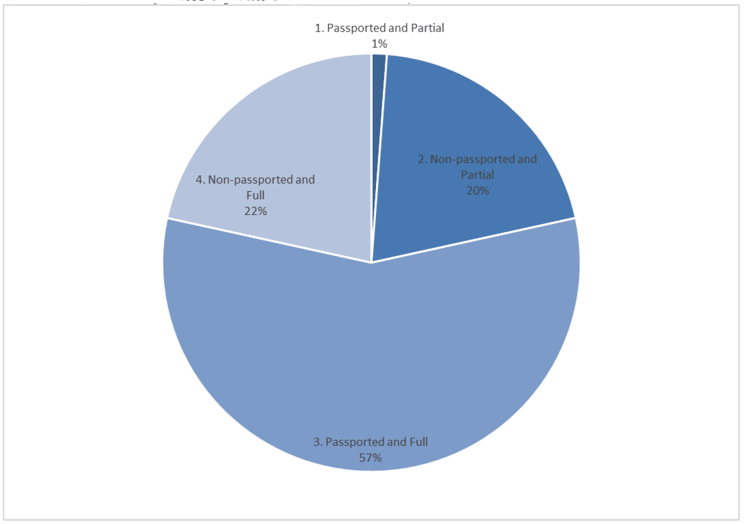
Contact
Email: Robin.Bennie@gov.scot
There is a problem
Thanks for your feedback